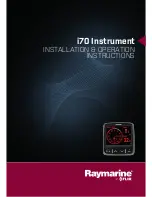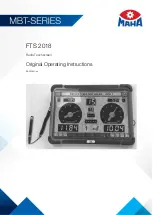
GENERAL
Hazardous Location (Haz Loc) DS/DSN/DR/DSDC
Series products are special use connectors rated for use
in Class I Division 2 and Zone 2 environments where ex-
plosive gases are not likely to be present or are present
for only short periods of time.
Haz Loc DS/DSN/DR/DSDC receptacles have a dead
front shutter, which isolates the female supply contacts
and prevents user exposure to live parts. The recep-
tacle’s safety shutter blocks access to the contacts
and can only be opened by their respective plugs with
compatible ratings and contact configurations.
There are inherent dangers
associated with electrical
products. Failure to follow safety precautions can result
in serious injury or death. These instructions must be
followed to ensure the safe and proper installation, oper-
ation and maintenance of the MELTRIC devices. Before
installation, disconnect all sources of power to the circuit
to eliminate the risk of electrical shock.
RATINGS
Haz Loc DS/DSN/DR/DSDC plugs and receptacles
are CSA listed in accordance with CSA 22.2 No.
182.1-07. The amperage, voltage, horsepower and
environmental ratings are indicated on the product
labels. In addition, these devices have been evaluated
by CSA for Class 1 Div 2 and Zone 2 hazardous loca-
tion applications per CSA 22.2 No. 213-M1987. They
are rated for NON-LOAD BREAK use only.
MELTRIC Haz Loc DS/DSN/DR/DSDC have maxi-
mum short circuit ratings based on fusing as indicated
on Table 1. Short circuit ratings apply only in ordinary
locations. The ratings for auxiliary contacts are shown
in Table 2. Pilot Contacts are rated for NON LOAD
BREAK use only.
DSDC are not short circuit rated.
* Rating applies with fusing up to this amperage.
Ratings are based on
tests performed with Mersen RK1 non-time delay current limiting fuses.
INSTALLATION
Haz Loc DS/DSN/DR/DSDC Hazardous devices
should be installed by qualified electricians in
accordance with all applicable local and national
electrical codes.
Before starting, verify that the power is off, that the
product ratings are appropriate for the application,
and that the conductors meet code requirements
and are within the capacities of the terminals
noted in Table 3.
Table 3 - Wiring
Terminal
Capacity
1
(in AWG)
Main Contacts
Aux. Contacts
2
Device
Min
Max
Max
DS20 – 20A
14
8
14
DR30
–
30A
14
8
14
DS30 – 30A
14
4
14
DR50
– 50A
14
4
14
DS60 – 60A
10
2
14
3
DS100C
–
100A
10
2
14
3
DSN150
4
–
150A
4
2/0
14
3
DS200
–
200A
4
4/0
14
3
DR250
–
250A
4
4/0
14
3
DSDC1
14
8
N/A
DSDC3
14
4
N/A
DSDC6
10
2
N/A
DSDC9
4
2/0
N/A
DSDC2
4
4/0
N/A
1
Capacity is based on THHN wire sizes
2
Auxiliary contacts are optional and may not be on all products.
3
Auxiliary contacts are prewired at the factory.
4
The DSN150 is intended to be wired with conductors rated 75°C
or higher. Use only wire/cable rated for hazardous duty.
General Notes and Precautions
1. Mounting screws are provided for use with
all accessories.
2. Devices should only be mounted to MELTRIC
approved accessories.
3. Wire strip lengths are indicated in Table 4. Strip
lengths for cable sheathing will depend on the
specific application.
Table 4 - Wire Strip Length – Dimensions A
Device
Receptacle
Plug/Inlet
Inches
mm
Inches
mm
DS20
Phase
7/16
11
3/4
19
DS20
Auxiliary
1/2
13
3/4
19
DR30
Phase
7/16
11
3/4
19
DR30
Auxiliary
1/2
13
3/4
19
DS30
Phase
9/16
14
7/8
22
DS30
Auxiliary
1/2
13
5/8
16
DR50
Phase
9/16
14
7/8
22
DR50
Auxiliary
1/2
13
5/8
16
DS60
Phase
15/16
24
15/16
24
DS100C
Phase
15/16
24
15/16
24
DSN150
Phase
1 3/16
30
1 3/16
30
DS200
Phase
1 1/2
30
1 1/2
30
DR250
Phase
1 1/2
30
1 1/2
30
DSDC1
Phase
7/16
11
3/4
19
DSDC3
Phase
9/16
14
7/8
22
DSDC6
Phase
15/16
24
15/16
24
DSDC9
Phase
1 3/16
30
1 3/16
30
DSDC2
Phase
1 1/2
30
1 1/2
30
4. Wiring terminals are spring assisted to prevent
loosening due to wire strand settlement, vibration
and thermal cycling.
NOTICE:
Do not over-
tighten the terminal screws. Appropriate tools
and tightening torques are indicated in Table 5.
Table 5 - Terminal Screw Tightening Torques
Device/Contact
Torque
Required Screwdriver or Allen
Wrench
in-lbs N-m
DS20
Phase
15
1.7
4 mm or 3/16" Precision Tip
DS20
Auxil.
15
1.7
4 mm or 3/16" Precision Tip
DR30
Phase
15
1.7
4 mm or 3/16" Precision Tip
DR30
Auxil.
15
1.7
4 mm or 3/16" Precision Tip
DS30
Phase
15
1.7
5 mm or 3/16" Precision Tip
DS30
Auxil.
9
1.7
3 mm or 3/16" Precision Tip
DR50
Phase
15
1.7
5 mm or 3/16" Precision Tip
DR50
Auxil.
9
1.7
3 mm or 3/16" Precision Tip
DS60 Phase
48
10.2
4 mm hex head
DS100C Phase
48
10.2
4 mm hex head
DSN150 Phase
90
5.4
4 mm hex head
DS200
Phase
130 14.7
5 mm hex head
DR250
Phase
130 14.7
5 mm hex head
DSDC1
Phase
15
1.7
1.7 4 mm or 3/16" Precision Tip
DSDC3
Phase
15
1.7
1.7 5 mm or 3/16" Precision Tip
DSDC6
Phase
48
10.2
4 mm hex head
DSDC9
Phase
90
5.4
4 mm hex head
DSDC2
Phase
130 14.7
5 mm hex head
5. Some auxiliary contacts are factory prewired.
Proper splicing method based on application
requirements should be practiced.
6.
NOTICE:
MELTRIC threaded handles come with
NPT tapered style threads. Proper thread sealing
method is recommended to maintain watertight-
ness of all NPT fittings and joints. Use with rated
cord grips.
Cord Mounted Devices
Strip the cable sheath to provide a workable wire
length, being mindful that the sheath must extend into
the handle to ensure proper strain relief and environ-
mental protection. Then strip the individual wires to the
lengths indicated in Table 4.
Back out the terminal screws on the receptacle (or
inlet) far enough (but not completely) to allow the
conductors to pass. Insert the conductors fully into
the proper terminals and tighten the screws with the
appropriate tool to the torque indicated in Table 5.
Verify that the cable jacket extends beyond the strain
relief and into the handle. Assemble the receptacle
(or inlet), the color coded gasket, the finger drawplate
(if needed), and the thin black drawplate gasket to the
handle with the four screws provided. Adjust the cable
location so that it will not be under tension inside the
handle and tighten the compression nut to secure the
cable.
Assembly for Mounted Receptacles (or Inlets)
In applications where Haz Loc DS/DSN/DR/DSDC
Receptacles (or inlets) are mounted to wall boxes,
panels or other equipment, optimal operation is
achieved when the device is installed with the latch
at the top and with the force from the cable being
exerted in a downward direction opposite the latch.
MELTRIC Corporation / 4765 W. Oakwood Park Drive Franklin, WI 53132
Tel. : 800 433 7642 / Fax : 414 433 2701 / e-mail : [email protected]
INSZONE2 D
A manufacturer of products using Marechal technology
meltric
.com
WARNING
DANGER
CAUTION
NOTICE
ADVERTENCIA
DANGER
CAUTION
AVISO
WARNING
DANGER
CAUTION
NOTICE
ADVERTENCIA
DANGER
CAUTION
AVISO
Table 2 - Auxiliary Contact Ratings
Device
120 VAC 240 VAC 480 VAC 600 VAC
DS20
6 A
3 A
1.5 A
1.2 A
DR30
6 A
3 A
1.5 A
1.2 A
DS30
6 A
3 A
1.5 A
1.2 A
DR50
6 A
3 A
1.5 A
1.2 A
DS60
6 A
3 A
1.5 A
1.2 A
DS100C
6 A
3 A
1.5 A
1.2 A
DSN150
1.5 A
.75 A
.37 A
.30 A
DS200
1.5 A
.75 A
.37 A
.3 A
DR250
1.5 A
.75 A
.37 A
.3 A
Table 1 - Short Circit Withstand Ratings
Device
Rating Fuse
Type*
DS20 – 20A
100kA @ 600VAC
RK1 80A
DR30 – 30A
100kA @ 600VAC
RK1 30A
DS30 – 30A
100kA @ 600VAC
RK1 125A
DR50 – 50A
100kA @ 600VAC
RK1 50A
DS60 – 60A
100kA @ 600VAC
RK1 250A
DS100C
– 100A
100kA @ 600VAC
RK1 250A
DSN150
– 150A
10kA @ 600VAC
RK1 400A
100kA @ 600VAC
RK1 225A
DS200 – 200A
10kA @ 600VAC
RK1 500A
DR250 – 250A
10kA @ 600VAC
RK1 500A
Mount with the latching pawl at
the top to counteract the weight
and strain of the plug and cable.
Mount the receptacle
at a downward angle
whenever possible.
©2022 MELTRIC Corporation. All rights reserved.
DX
CONSIGNES D’UTILISATION
ENGLISH OPERATING INSTRUCTIONS
ZONE 2
DS/DSN/DR/DSDC
























